These images show the development of clear-felling sites in 1, 17, 19, 33, 60 and over 200 years

Research Professor Jari Hynynen at Natural Resources Institute Finland talks about the carbon sequestering capacity of different forest plots. Forest Specialist Anne Polojärvi emphasizes the significance of soil manipulation for forest growth.
A clear-felled site will be reafforested much more rapidly if the soil is manipulated and planted with seedlings. The forest will also regenerate itself spontaneously, but the process is much slower.
These conclusions may be drawn from eight different forest plots that forest.fi visited in the summer of 2022 Our aim was to see the growth of forests of different types and ages. The plots are located near the midriff of Finland, in the Käsmä area in the municipality of Kuusamo, about 100 kilometres south of the Polar Circle.
The plots were analysed for us by Anne Polojärvi, Forest Specialist at Kuusamo Forest Management Association. She pointed out the special characteristics of the Kuusamo area that affect the rate of forest growth here.
In this upland area, the vegetation zone and annual temperature sum are different from other areas on the same latitude. All of Kuusamo is over 200 metres above sea level, and so the climatic conditions correspond to those in Central Lapland.
’The temperature sum in Kuusamo is about the same as in Sodankylä. Altitude plays an important part in the growth rate of forests and other vegetation,’ Polojärvi says.
Global warming visible in the north
The annual temperature sum is calculated by adding up the mean daily temperatures during the growing season. Included are the 24-hour periods when the temperature is over five degrees centigrade. Sodankylä is situated about 200 kilometres north-west of Kuusamo. As in other cold areas, global warming can be seen in Kuusamo.
’You can see a significant increase in the annual temperature sums. These days, trees come into leaf in late May or early June, where before you’d have been lucky if you could make a proper sauna whisk at Midsummer,’ Polojärvi says.
You can see a significant increase in the annual temperature sums. These days, trees come into leaf in late May or early June, where before you’d have been lucky if you could make a proper sauna whisk at Midsummer.
In the 1980s, Kuusamo experienced some cold summers and winters. The year 1987 was particularly cold, with a temperature sum practically the same as at the forest limit. Polojärvi says that since then, the annual temperature sum has increased significantly.
The special characteristics of Kuusamo also include high humidity and forest damage caused by snow, both of which slow down the growth of forests. In the humid climate of Kuusamo rainfall is greater than evaporation.
’Getting plenty of rain means that paludification is more rapid and a fairly thick layer of raw humus builds up on top of mineral soils. There are plenty of rich mesic heath forests here,’ Polojärvi explains.
Information used in this article was also provided by forest owner Eero Karjalainen in Kuusamo.
In addition to Polojärvi, Research Professor Jari Hynynen at Natural Resources Institute Finland commented on the plots from the viewpoint of carbon sequestering.
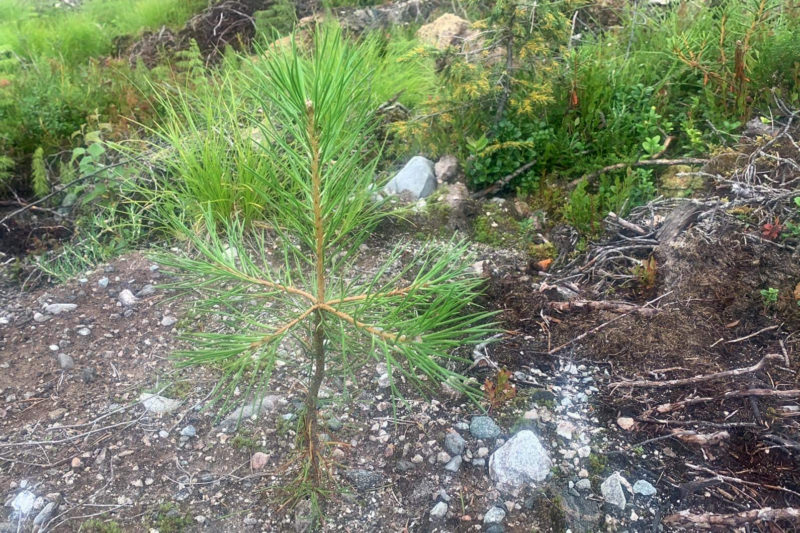
Scots pine, planted in 2021, height 40 centimetres.
Polojärvi: ”These pine seedlings, about four years old, are growing at a good rate in a paludified area with quite a lot of cloudberry, Rhododendron tomentosum and grasses. Birches springing up near the seedlings will have to be removed later.
The soil has been manipulated to reveal mineral soil and create a mound. In the mound, the temperature sum for the seedling is 30 percent higher than in dense soil. In Kuusamo, increasing the greater temperature sum gives a significant boost to the initial growth. We know from previous experience that the growth of forests planted on ploughed sites in the 1960s to 1980s has been highly successful.’
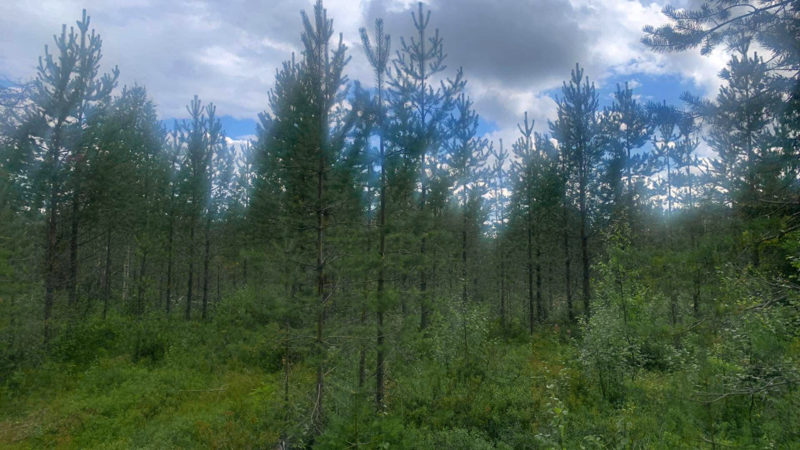
Scots pine, planted in 2005, height 7 metres.
Polojärvi: ’The site was ploughed and the saplings have been tended. There are some open spots, but the stand is in excellent growth.’
Hynynen: ’A pine stand in rapid growth with good annual shoots. In previous years people were surprised at the growth rates of forests in Kuusamo and Northern Ostrobothnia. It was said that deep ploughing left the forests looking awful and difficult to move in, but it does help tree growth a lot.’
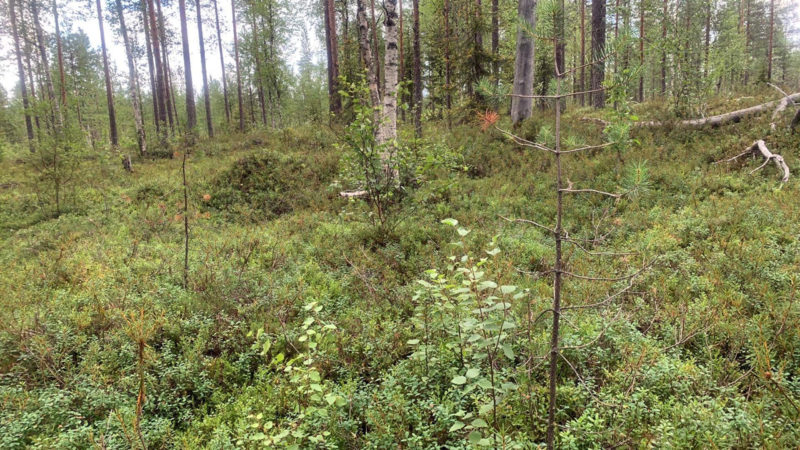
Clear-cut for arable field in 1962, then not taken into use, so spontaneously afforested. Scots pine, about 11 metres, spruce about 10 metres and birch below that. Trees of varying ages. Originally treated as part of the plot seen in the image above.
Polojärvi: ’Mixed stand, about 40 to 50 years old, looks thin and not many trees could be stout. The humus layer appears thick and that’ll have slowed down the regeneration. You can’t see an enormous number of saplings, just some single, poor-looking pine saplings and a few birch shoots.
On soils like this, with plenty of humus and maybe some paludification, pine is not suitable for continuous-growth forestry. It may have taken twenty yeas before any pines started to grow, though of course, there is a forest of sorts, even if it’s been left to fend for itself. This plot was allowed to afforest 60 years ago, but a 20-year-old pine stand planted as densely as is reasonable may already contain more timber than this plot. An effective and rapid regeneration of a site gives you the same volume of timber in just a third of the time.
Continuous-cover forestry is often linked with uneven-aged stands. Even-aged stands are difficult in terms of continuous cover, though you can see a single standing dead pine and some fairly old pines here. Continuous cover produces plenty of small clearings, and that gives the possibility of damage due to snow load. That will easily happen at stand edges.’
Hynynen: ’You can see structural heterogeneity here, but if you mainly focus on timber production, the smaller trees don’t look all that useful. Carbon sequestering is not very high, though a plot like this does have some value. At this stage, this plot sequesters less carbon than the adjacent one, which is growing rapidly (see plot planted in 2005), but 50 years on from now the situation will be reversed.
Pretty soon, this stand will be way better as a carbon sink, up to the next regeneration felling. After regeneration fellings the carbon left in stumps, roots and felling residue is slowly released. The carbon emission continues until the point when the photosynthesis by the saplings and the vegetation is higher than the emissions from decomposition. In Kuusamo, a plot will form a carbon sink in about 10–20 years, depending on stand density.’
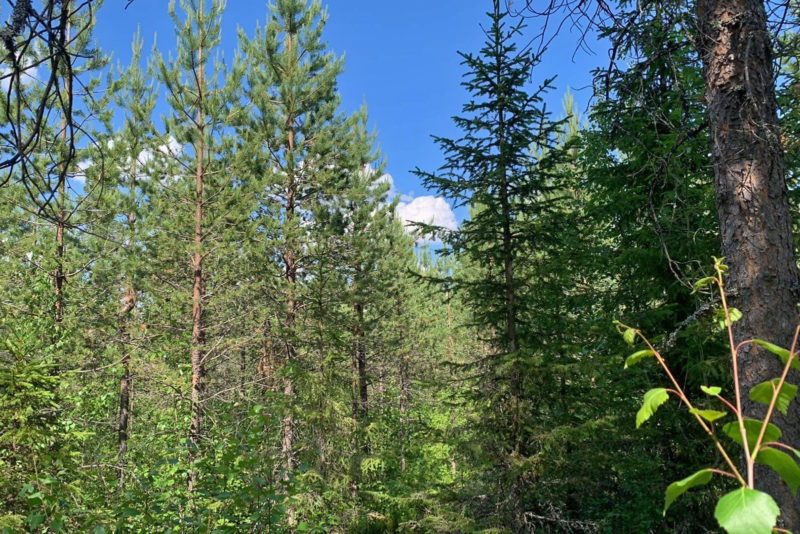
Scots pine, planted in 2003, height 7 metres.
Polojärvi: ’The stand looks dense, but is no denser than recommended, probably with 2,000 trees per hectare. In five years there’ll be more timber than in the forest that’s been regenerating naturally for 60 years (see image above).
In the undergrowth there are birches, one metre to one and a half metres high. The stand has been tended in 2016, and the next thing will be a first thinning in about ten years, or maybe a bit earlier.’
Hynynen: ’A good-looking stand with some birches, and there’s even some standing deadwood.’

Mixed stand of spruce, Scots pine and birch. The plot was clear-felled in early 1960s. First used to pasture cows and then left to regenerate.
Polojärvi: ’The plot contains trees of different heights. Pines up to 13 metres, spruces under 10 metres. Young saplings can also be seen. The forest has sprung up naturally, even with no forestry operations. The trees appear in good health. This is what has come about in 60 years, while a forest planted at the same time would be ripe for regeneration felling.
During this time the forest has not yielded thinning revenue but on the other hand there have been no regeneration costs and a forest has still sprung up. If you leave this plot for another 20 to 30 years, the conifers may become stout and valuable. It might still make sense to carry out one thinning to ensure that the conifers gain more size.
The yield would be 30 solid cubic metres per hectare, while the plot nearby (see image above) will yield 50 solid cubic metres in half the time.’
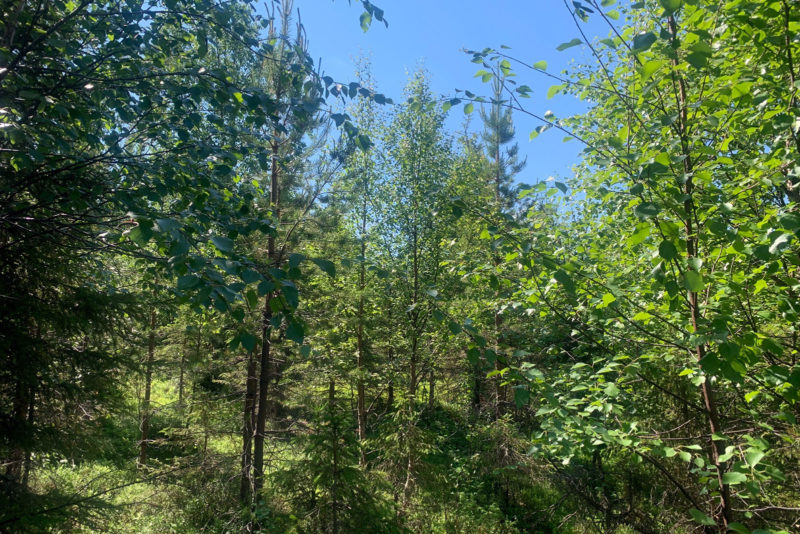
Mixed stand, Scots pine and spruce. Planted in 1989.
Polojärvi: ’All young stands in Kuusamo are situated at a fairly high altitude. Here, too, the altitude is over 300 metres above sea level. You can see the effect of this in the tree height, 11 to 12 metres. The regeneration measures have been very thorough. The soil was manipulated and the seedlings were planted carefully.
The soil is mesic heath with a thick layer of raw humus, so the plot was ploughed. The ploughing ensured a higher temperature sum at the initial stage, which guaranteed that the seedlings thrived and early growth was promoted. By now, the volume of timber is about one hundred solid cubic metres per hectare.
Without reindeer and elk, there would be many more broadleave shoots. These animals are very effective landscapers around here. The plot will be thinned in five years. There is already some logwood by now, though fibrewood is still dominant. After thinning, the forest will grow stouter fairly rapidly, with the thickest trees left to grow and fertilized by felling residue.’
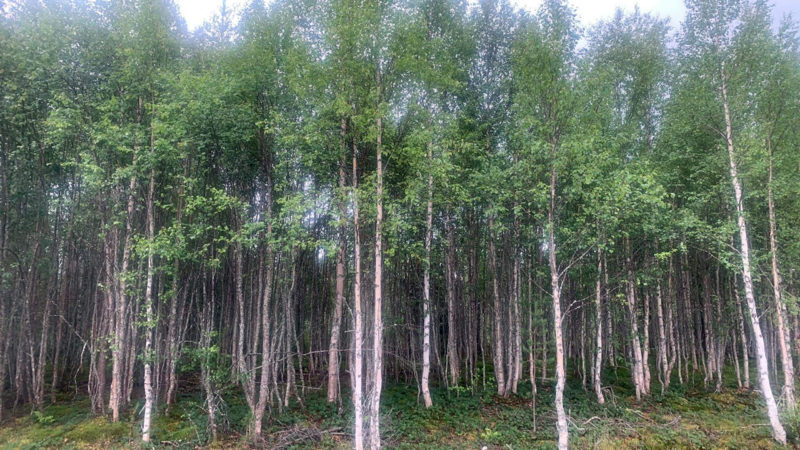
Birch, height about 11 metres. Previously used for agriculture.
Polojärvi: ’The birch has produced an even stand, though in fields established on mires it normally likes to grow beside ditches. Most likely this was originally a spruce mire. The soil is peaty, and the undergrowth contains such plants as cloudberry.
In the 1980s, the afforestation of agricultural fields typically failed due to nutritional disturbances, because the plots were not fertilized. And if the ditching was inadequate, the site would revert back to mire. On this plot, nothing has been done, yet the trees have grown enormously, because the hydrology is good. If the plot had been managed it would now carry a decent forest, though it’s not too late to do something even now.’
Hynynen: ’These trees make a good carbon sink. The whole space for growth is in use and the volume of timber will continue to increase for some time. The local heating plant would probably like to remove half of those trees for energy.
For this site, the owner could well apply for a forestry subsidy available to private forest owners, as this is so clearly suitable for energy wood.’
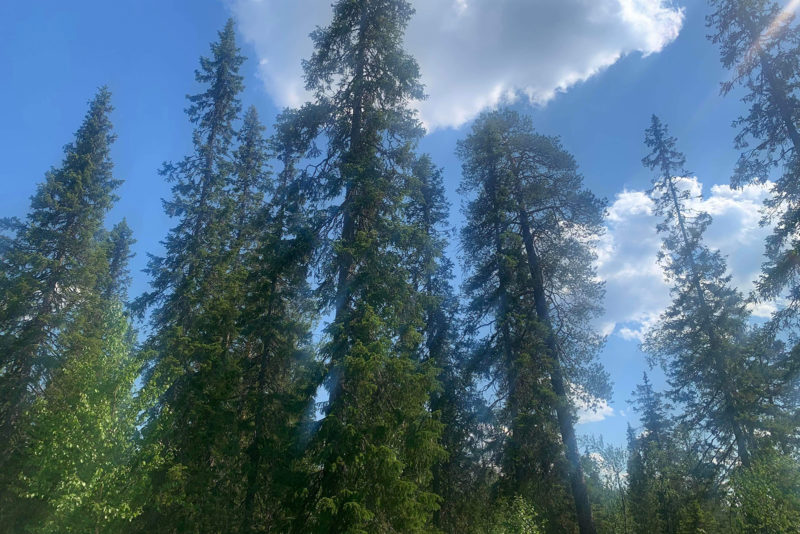
Old-growth forest, 20-metre spruce, birch and Scots pine.
Polojärvi: ’The trees appear really tall, for the normal height of spruce stands in Kuusamo is 15 to 16 metres. In the south of Kuusamo, the annual temperature sum is higher than in the centre, or example. The pines are over 200 years old and the spruces almost as old. A Scots pine can still be green at the age of 500, unlike a spruce. At the age of 200, spruces here begin to die at the top, though they can still remain upright for quite a while.
The oldest stands in Kuusamo were strongly dominated by spruce, because pine was easier to chop down for firewood and construction. In a forest this old there is normally little birch, because it will rot earlier. The soil here is stony and paludified and has a thick layer of humus, making it a difficult spot for regeneration.’
Hynynen: ’This forest no longer grows at a noticeable rate, if at all. This is more a carbon storage than a carbon sink. 50 years ago the sequestering rate was much higher, but the plot is still a net sink. In an old-growth stand the growth rate is slower even when some undergrowth is appearing.’
Length and heat of summer determine growth
’The length, temperature and rainfall of the growing season are what determine the growing environment and growth conditions,’ is how Research Professor Hynynen sums up the principles of forest growth.
In the north of southern Finland, the shorter growing season and smaller temperature sums are visible in the tree stock.
’On the best sites in southern Finland, the annual increment may be over ten cubic metres per hectare, but in the north it will only be a few cubic metres per hectare, even on a similar growing site. Geography makes itself felt in the length of the growing season and the temperature sum,’ Hynynen says.
Nutrient level on growing site is important
Another important factor affecting tree growth is the availability of nutrients and water.
’Mineral soils are different from peat. This is something that forest management cannot do much about. The availability of nutrients can be improved by fertilization, the hydrology of forests on mires can be regulated by draining and maintaining existing ditches,’ Hynynen explains.
Peatland forests often yield less felling revenue than those on mineral soils, and the cost of management and felling is often higher.
Hynynen says that one third of Finnish forests grow on peatlands. After the Ice Age, mires were created in depressions that began to collect water. Peat begins to form in anoxic conditions, where the decomposition of dead vegetation is incomplete.
Mineral soils are different from peat. This is something that forest management cannot do much about. The availability of nutrients can be improved by fertilization, the hydrology of forests on mires can be regulated by draining and maintaining existing ditches.
Hynynen points out that there is variation between peaty soils. They are classified according to location, vegetation and eutrophication; some are called poor pine mires, others rich spruce mires, with a varying thickness and nutrient content of the peat layer.
’Peat makes a special growing site. In a spruce mire with a thin peat layer, the trees will grow without any particular help, but most afforested mires will at some point have been drained to produce timber, because mires normally have too much water for good tree growth,’ Hynynen says.
Healths may contain humus or consist of till
Heaths mostly consist of till or, at best, soil with some humus.
’In the south, the best sites have been cleared for agriculture, though there are still herb-rich forests and heath forests resembling these left,’ Hynynen says.
Forest growth can be accelerated by increasing the availability of the limiting nutrient. This is the nutrient that will be used up first so that tree growth is slowed down. On heaths, the limiting nutrient is nitrogen, while peatlands normally have an abundance of it but are short on potassium and phosphorus.
That’s why peatlands are fertilized with ash, since it contains everything but nitrogen. On heaths, using ash only does not really increase growth.
’That’s why peatlands are fertilized with ash, since it contains everything but nitrogen. On heaths, using ash only does not really increase growth,’ Hynynen says.
Forest damage that would limit growth has, according to Hynynen, remained ’small-scale’ in Finland, at least so far. However, elk traditionally alter the landscape by feeding on young pines and broadleaves.
’Elks are the reason why you mostly just see spruces in the south,’ Hynynen says.
Growing stock has increased
The growing stock in Finland has increased by half since 1990, even though fellings have also increased. Hynynen says that two thirds of this increase are due to forest management.
’Sites have been drained and forest has been regenerated through cultivation instead of naturally Young stands have been tended and thinned and the species used have been selected to suit the site. Thanks to this, we have been able to increase both growth and fellings,’ Hynynen explains.
Sites have been drained and forest has been regenerated through cultivation instead of naturally Young stands have been tended and thinned and the species used have been selected to suit the site.
According to Hynynen, one third of the increase in growth is due to the climate. The growing conditions have improved since the 1990s, but according to the inventory published last November by Natural Resources Institute Finland, the rate of increase in forest growth has begun to slow down in Finland, though the volume of tree stock was found to have grown.
’So far, we don’t know enough of the effect of climate change, but the hypothesis is that the growth of trees in Finland could slow down or perhaps stop altogether,’ Hynynen says.
He points out that there is no reason to draw ’dramatic conclusions’ from the difference between two inventories, as that can be affected by a number of things.
’Still, it appears to be that the volume of trees growing within a limited area is reaching its peak. Unless some changes are made in how forests are dealt with, I doubt that the growth can continue at the same rate,’ Hynynen says.
’Felling levels may perhaps not be increased’
According to Natural Resources Institute Finland, the amount of stemwood felled and tree removals in 2021 was 92 million cubic metres. The increment of new stemwood was 103 million cubic metres.
Hynynen considers it possible that fellings may not be further increased, to avoid exceeding the volume of forest growth.
Hynynen reminds that fellings decrease the binding of carbon.
’The current forestry methods, with thinnings and rotation periods, do not maximise the amount of carbon in tree stock or, actually, the yield of stemwood,’ Hynynen says.
He says that fellings could still be increased with a couple of measures, without decreasing carbon sequestering.
’We could carry out lighter thinnings and prolong the rotation period. This would increase carbon sequestering and still maintain the current felling levels,’ Hynynen says.
’Though in terms of profitability, this would not be a better option, thinking about current sales prices and costs. But in terms of timber production this might be a compromise we could live with,’ Hynynen says.
He says that the carbon sequestering and vitality of forests would also be increased by fertilization, using nursery seedlings and seed, and increasing tree density.
’All this would produce a greater increment even at current felling levels,’ he says.
’Finnish forests are growing well’
Jari Hynynen disagrees with those who say that carbon sequestering is highest in non-managed forests. He says that the majority of Finnish forests are healthy and in a phase of good growth.
’The carbon storages would undoubtedly grow if fellings were to stop for the next ten years, but over time that would not be a very sustainable way of forest management in terms of carbon sequestering,’ Hynynen says.
’The time span of what is sustainable and what is not, is fairly long.’
Hynynen explains that if fellings were stopped in Finland, the forests would gradually grow older and denser. They would lose vitality and the risk of damage would grow. At the same time, carbon sequestering would decrease and before long, would reach zero, at which point the forest would reach an equilibrium.
The forest would then form a huge carbon storage, but it would no longer absorb any carbon from the atmosphere.
’The net increase of carbon sequestering and biomass would be zero. All carbon sequestered dies somewhere else. The forest would then form a huge carbon storage, but it would no longer absorb any carbon from the atmosphere,’ Hynynen points out.
Reaching the equilibrium would take several centuries.
’It would be a really long process, but on a rich site it would take less time. Theoretically we would be moving in that direction if we stopped doing anything,’ Hynynen says.
According to Hynynen, the best thing for carbon sequestering is a forest with healthy and vital trees.
’In such a case the carbon storage is reasonable and new carbon is being bound. We all know that ultimately the crux is how much we remove wood from the forest and what we make of that wood,’ Hynynen says.
Behaviour of peatlands is ’a tough challenge’
Hynynen says that peatlands are a tough nut to crack. It is difficult to study the carbon emissions from them.
’Carbon emissions from peatlands, especially spruce mires, are crucial. The amount of carbon bound in soil can be five times as much as in trees,’ says Hynynen.
If the groundwater table is almost at surface level, methane is released into the atmosphere. If the groundwater sinks really low, carbon dioxide will be released. There is great fluctuation.
A lot depends on groundwater level.
’If the groundwater table is almost at surface level, methane is released into the atmosphere. If the groundwater sinks really low, carbon dioxide will be released. There is great fluctuation,’ Hynynen says.
With plenty of trees, groundwater tables will be low. After a regeneration felling they will rise since the trees are no longer there to evaporate water.
’One solution is to manage the forest so as to keep the fluctuation to a minimum, which would be optimal in terms of carbon. However, there are many things here that we don’t know as yet. It is difficult to measure the amount of carbon bound in soil across the whole country. It is more or less guesswork, though some very rough calculations have been made”’ Hynynen says.
Finnish forests are ageing
In May 2022, Natural Resources Institute Finland announced that Finnish forests are binding less carbon dioxide than before. Hynynen does not think that this trend is permanent, though he does say he takes this seriously. The decrease in growth rates has been most noticeable in pines in central and northern Finland.
He considers the probable cause to be that the forests are ageing.
’What is called intensive forestry was carried on in the 1960s to 1980s in particular. In that period, plenty of peatlands were drained and regeneration fellings were frequent. The forest generation created then begins to be at an age where it does not contribute to growth much,’ Hynynen says.
In an ordinary stand of pines, according to Hynynen, the increase in tree height and thickness is at its most rapid at the age of 20 to 30 years. The timber volume and carbon sequestering are at their peak when the trees are 40 to 60 years old.
We still don’t know the impact of climate change on tree growth very well. So far, the warming has improved growth, but if we start getting dry periods or something else comes up, things will change a lot.
’We still don’t know the impact of climate change on tree growth very well. So far, the warming has improved growth, but if we start getting dry periods or something else comes up, things will change a lot,’ Hynynen says.
In good summers trees will grow better on average than in poor ones. though growth does vary according to species. The matter is currently being studied.
’Pines, spruces and birches all react to the climate in different ways,’ Hynynen says.
On peatlands, spruce growth would be improved by maintenance ditching.
’Then again, we want to do less maintenance ditching on peatlands, because it is an environmental risk. There is leaching into waterways, and the fluctuation of groundwater tables causes another negative change. Ash fertilization could be used to maintain growth without fiddling with the drainage,’ Hynynen says.